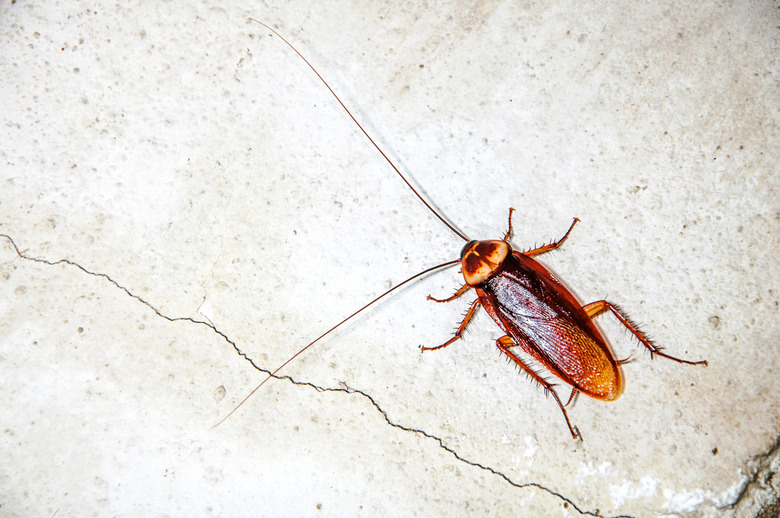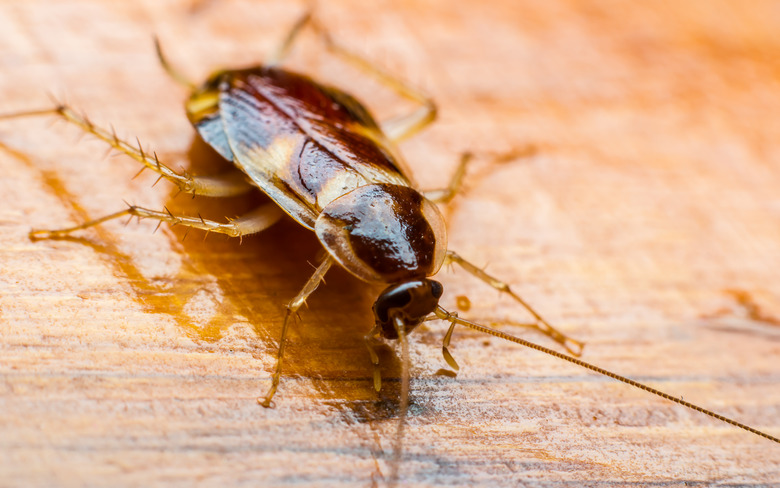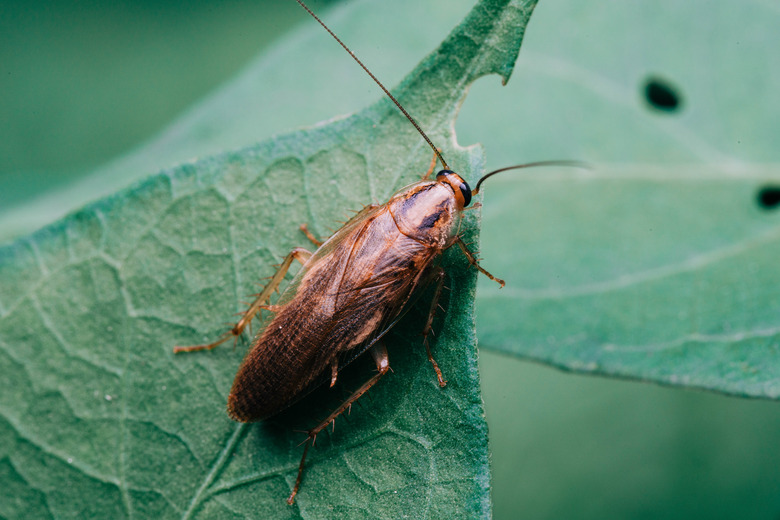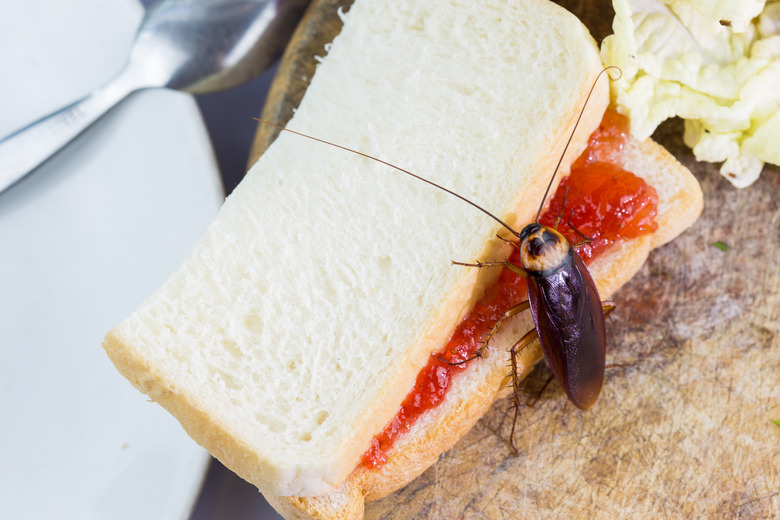How To Get Rid Of Cockroaches
We may receive a commission on purchases made from links.
Few things are more unsettling than seeing a cockroach skitter across the floor when you turn on the light in the kitchen or bathroom in the middle of the night. Cockroaches aren't just gross to look at; they actually carry dangerous bacteria wherever they walk. To make matters worse, cockroaches are fast breeders — so fast that a single female German cockroach can lead to an infestation of more than 30,000 bugs in a single year.
Fortunately, when it comes to getting rid of cockroaches, you have a lot of effective options available to you, from setting out borax or baking soda to hiring a professional exterminator and setting off bug bombs.
What Do Cockroaches Look Like?
What Do Cockroaches Look Like?
- Species name: American cockroach (Periplaneta americana), German cockroach (Blattella germanica), brown-banded cockroach (Supella longipalpa)
- Physical characteristics: The most common cockroach varieties in the United States are between 1/2 and 2 inches long. They have varying body shapes, but whether thin or round, they are typically flat and oval-shaped with long legs and long antennae. Cockroaches usually come in varying shades of reddish-brown.
- Wings or wingless? While almost all species have wings as adults, most cockroaches cannot fly.
- Color/species varieties: There are over 4,000 species of cockroaches, and around 70 can be found in the U.S. Some of the most common varieties in American homes include American cockroaches, German cockroaches, and brown-banded cockroaches.
- How to tell apart from lookalikes: Cockroaches are sometimes confused with beetles or crickets. Beetles have shorter legs and antennae and a hard exoskeleton that makes a distinctive crunch when crushed. Crickets have long, strong back legs that are used for jumping. Typically, beetles and crickets stay outside, whereas cockroaches prefer living in homes.
How to Get Rid of Cockroaches
How to Get Rid of Cockroaches
There are many methods to exterminate roaches, so it's important to consider the pros and cons of each technique to find the right solution for your home.
Use Boric Acid
One of the most popular methods of DIY cockroach control is boric acid, a naturally occurring mineral. It's typically easiest to buy it as borax, which is often sold as a laundry detergent booster. Boric acid quickly kills cockroaches by shutting down their nervous and digestive systems.
There are many effective ways to use boric acid as a natural roach killer:
- You can sprinkle it onto a paper plate and then bait the plate by putting a small spoonful of peanut butter in the middle.
- You can make it into a sweet dough by mixing it with equal parts of water, flour, and sugar.
- You can mix it with sugar and place it in small piles.
Whatever method you choose, simply place your poison bait in dark corners, crevices, and other areas where roaches may hide.
Try Diatomaceous Earth
Diatomaceous earth is made from small bits of fossilized algae that causes damage to the exoskeleton of insects and helps dehydrate them from the inside out. Simply sprinkle a light coating on any area where you've spotted roaches. While diatomaceous earth is safer than pesticides, the powder can still be an eye, throat, and skin irritant, so it should be avoided around pets and children.
Combine Baking Soda with Sugar
You probably already have baking soda at home, and you can use this to start killing off roaches immediately. Just combine the baking soda with sugar and sprinkle it where you suspect roaches are hiding. Baking soda creates gas in a roach's stomach, causing it to explode.
Use Glue Traps
Glue traps, sometimes called "roach motels," use a scent to attract roaches and then catch roaches after they attempt to climb over the sticky surface, leaving them to starve to death. Simply place these in dark crevices where you've noticed roaches hanging out, particularly under your fridge and sinks, and replace as needed.
It's worth mentioning that even if you don't intend to kill off all of your roaches with glue traps, they can be an effective first step in your overall pest control plan because they can help you identify where your roaches are congregating and what type of roach you're dealing with.
Try Roach Bait
Commercial roach pesticides are sold in many forms, including gels, or bait stations with liquid concentrates or powdered poisons. The gels are a little messier and need to be applied a few drops at a time along baseboards, cracks in your walls or floors, or other places where roaches tend to travel. The bait stations are a little easier to use and just need to be opened and placed in areas with high roach activity.
Both gels and bait stations smell attractive to hungry roaches, who then eat the poison. In many cases, the poisoned roaches die in the nest, and other cockroaches will eat them, helping to pass the poison through the whole colony. These all effectively kill cockroaches.
Use a Roach Spray
While there are some roach sprays that kill on contact, the best of these products drives roaches out of their hiding spaces and poisons them at the same time. These types of roach sprays will also serve as a repellent and will keep roaches out of your home for a few months following your initial treatment. Simply spray into corners, cracks, and crevices where roaches may congregate.
When to Hire a Pro
When to Hire a Pro
Most roach problems can be tackled fairly easily by homeowners, but you might want to call in a pro to handle your roach control issues if you want quick results and you don't feel comfortable handling commercial pesticides. Additionally, research shows that cockroaches are becoming increasingly resistant to commercial insecticides, so if you've tried to kill the roaches and aren't having any success, it might be time to call a professional.
When talking to an exterminator, be sure to mention if you have young children and pets because it's important that they take measures to keep your family members safe from dangerous pesticides. While pest control companies may use different methods to address the infestation, it's important that the company communicates the plan and addresses your concerns and questions.
Depending on the severity of the infestation, treatments may take as little as a week or as long as a few months. Similarly, the number of roaches in your home will affect the price of treatment. Generally, homeowners should expect to pay between $100 and $300.
Getting Rid of Cockroaches Naturally
Getting
Rid of Cockroaches Naturally
While there are many natural ways to kill cockroaches, if you want to get rid of a small roach infestation without killing them, you can always try using herbal essential oils to repel the insects. The smells of lemon, lemongrass, rosemary, and peppermint are all good natural roach repellents. If you want to try a natural repellent, simply mix a few drops of these essential oils with water and then spray the mixture where you have seen roaches. While this type of treatment will not kill the roaches, it may make them leave your house.
Keep in mind that essential oils may be hazardous to pets, so use these away from animals. Also remember that if this method doesn't work, the cockroaches will continue breeding, making your problem exponentially worse.
How Quickly Can You Get Rid of Cockroaches?
How Quickly Can You Get Rid of Cockroaches?
For the quickest results, start by putting a few glue traps, or "roach motels," in dark corners and crevices in any rooms where you suspect roaches may be hiding. Check the traps a few times a day for a few days to see where the largest concentration of roach activity is occurring. Typically, glue traps won't be enough to eliminate an infestation, but they can tell you where the roaches are hiding.
Once you know where the roaches are, place bait stations or a gel solution in areas where the roaches are most active. These products take less than 24 hours to work, and because they continue to kill roaches that cannibalize the deceased roaches, the products can wipe out whole colonies much quicker than other options.
Always take care to clean up the dead roaches after exterminating them since their bodies are common home allergens. Clean any surfaces they have touched to remove any dangerous germs they may have tracked through your home.
How Cockroaches Get In Your House
How Cockroaches Get In Your House
While cockroaches tend to be attracted to dirty homes, clean homes can also be invaded, usually due to the availability of water from leaky pipes or drippy faucets, which is another reason to hire a plumber even for a little trickle. Cockroaches are sometimes simply seeking shelter, so they will also invade homes that are easy to enter.If you find cockroaches in your house, try to identify where they are getting in and attempt to seal all entry points. Use caulk, expanding foam, and weatherstripping to seal cracks and holes on the outside, under your baseboards, in your cabinets, in the walls, around pipes, and near your doors and windows since these are the most common means of entry.
How to Prevent Cockroaches
How to Prevent Cockroaches
Cleaning your home is both the best way to prevent a roach infestation and often the first step in eradicating the pests from your home. Cockroaches typically enter homes looking for food and water sources, so keeping your home clean, particularly the bathroom and kitchen, can prevent them from coming inside in the first place.
To discourage these invaders, eliminate their water and food sources by:
- Never leaving out dirty dishes.
- Sealing food in airtight containers.
- Cleaning spills immediately.
- Wiping your stove top after cooking.
- Cleaning the crumbs from your toaster and toaster oven.
- Keeping your sinks and bathtubs clean.
- Sweeping, mopping, and vacuuming every few days.
- Throwing out old cardboard boxes and newspapers.
- Eliminating clutter as much as possible.
- Storing pet food in airtight containers and cleaning your pet's food bowl after every use.
- Fixing leaky pipes and faucets.
Do Cockroaches Spread Disease?
Do Cockroaches
Spread Disease?
While cockroaches are not a threat to your home itself and do not bite people, they are still a dangerous pest that needs to be eradicated. They carry bacteria, including salmonella, staphylococcus, and streptococcus, and they have been known to carry intestinal diseases, including dysentery, cholera, and typhoid fever. Additionally, the feces, eggs, saliva, and shedded exoskeletons of cockroaches are some of the top sources of indoor allergens.
References
- Anti-Pesto Bug Killers: How to Get Rid of Cockroaches
- Cockroach Facts: Where do Roaches Hide?
- Cockroach Facts: How to Hire A Roach Exterminator
- Northwest: What Attracts Cockroaches to a Clean House?
- University of Minnesota Extension: Cockroaches
- Home Depot: How to Get Rid of Roaches
- Smith's Pest Management: How To Get Rid Of Roaches In Your Home: A Complete Guide [2021]
- Terminix: 5 Best Ways to Get Rid Of Roaches
- Terminix: Bugs That Look Like Cockroaches



